The most powerful naval guns of World War II
The biggest guns in stories... The Second World War demonstrated the importance of large caliber artillery. At the same time, the caliber race took place not only on land, but also at sea. Almost all naval powers developed powerful artillery systems for their battleships, which were supposed to provide ships with superiority over the enemy.
Many countries were able to develop artillery guns with a caliber of more than 400 mm for their surface warships. The Japanese went farthest, armed the Yamato-class battleships with 460-mm naval guns. It was the Japanese naval gun that became the largest and most powerful among all the naval guns that participated in World War II.
At the same time, the 406-mm caliber submitted to the United States, which massively used such weapons on their battleships. Germany and the USSR also created 406-mm naval guns, however, they never made it to the ships. The Germans were able to assemble at least a dozen 406-mm guns, all of which were used exclusively in coastal artillery. The Soviet Union created its 406-mm B-37 naval gun. As part of the MP-10 experimental tower installation, the gun took part in the defense of Leningrad.
The main caliber "Yamato"
Among the most powerful naval guns of the Second World War, the first place rightfully belongs to the Japanese naval naval 460-mm gun Type 94. This gun was in service with the two largest and most famous today Japanese battleships Yamato and Musashi. It was planned that it would be installed on the third battleship of the Yamato-class, but the Shinano was subsequently completed as an aircraft carrier, and it did not need main caliber artillery.
Work on the 460-mm naval gun was carried out in Japan from 1934 to 1939, the work was supervised by engineer S. Hada. Unique naval artillery was developed in the strictest secrecy. The weapon was adopted under the designation 40-SK Mod. 94. This designation persisted until the end of the war and was part of the disinformation.
The measures taken by the Japanese Navy to maintain secrecy around this artillery system were unprecedented. The Americans were only able to find out about the true caliber of the Yamato-class battleships' artillery only after the end of hostilities, before that they believed that the most advanced Japanese battleships were armed with 406-mm guns.
The release of new guns continued in Japan from 1938 to 1940. During this time, it was possible to create 27 barrels, including two intended for field tests. Six complete three-gun turret installations were installed on two battleships Yamato and Musashi, the remaining barrels were intended for further armament of the third battleship of this type.
The three-gun turret mounts of the battleship "Yamato" weighed 2510 tons, with ammunition - 2774 tons, this exceeded the displacement of most destroyers during the Second World War. For firing 460-mm guns, armor-piercing and incendiary shells were developed. The latter were, in fact, anti-aircraft ammunition containing 600 fragmentation and 900 incendiary elements. The Type 460 91 mm armor-piercing shell was the heaviest shell used in the naval battles of World War II. Its mass was 1460 kg.
The 460-mm Type 94 naval gun could send shells weighing almost 1,5 tons to a maximum range of 42 km, and a height reach of 11 km. The initial speed of the projectile is 780-805 m / s. The maximum rate of fire of the guns was 1,5–2 rounds per minute. Elevation angles from -5 to +45 degrees.
Barrel length of 40-SK Mod. 94 was 45 calibers, more than 20 meters. The weight of the barrel together with the bolt exceeded 165 kg. The shells of this artillery system were distinguished by good armor penetration. At a distance of 000 kilometers, the 20-mm Yamato armor-piercing projectile penetrated 460 mm of vertical armor.
Experts assessed the Japanese Type 94 naval gun as very reliable. The artillery system of the most powerful Japanese battleships did not suffer from the "childhood diseases" characteristic of sophisticated equipment. True, this still did not allow the guns and battleships to prove themselves. Created to combat the battleships of the American fleet both Japanese heavy-duty battleships were eventually killed aviationwithout having time to inflict any significant losses on the enemy.
Guns for German super battleships
Before the outbreak of World War II, the battleships Bismarck and Tirpitz were laid down and built in Germany. Battleships were commissioned after the outbreak of hostilities. At the same time, the main caliber of the pride of the German fleet was 380-mm guns. These were powerful and quite successful guns, but at that time many battleships of Germany's opponents could boast of a large caliber of artillery.
The H-class battleships were supposed to rectify the situation at sea. As part of Germany's ambitious shipbuilding program from 1939 (hence the other name for the project "N-39"), it was planned to build six battleships of a new type at once, which would have surpassed the Bismarck in size. The main armament of the new ships was to be 406-mm or 420-mm guns.
The development of these artillery systems was carried out in Germany in the 1930s. The guns were created by the Krupp concern and were fully ready by 1934, as were the 380-mm Bismarck guns. The 406 mm guns were designated 40 cm SKC / 34. The project provided for the boring of their barrels to a caliber of 420 mm, in this form of guns it was also planned to use in the development of battleships of the "N" project.
Due to the cancellation of the construction of H-class battleships, the guns were presented only in coastal artillery. Before the start of World War II, only two hulls of new battleships were laid in Germany, the rest of the ships were not even laid down. At the same time, the project was abandoned already in October 1939 after the outbreak of World War II.
By that time, 12 406-mm guns had been assembled at the Krupp factories. Among them, one is experimental, three are in the ship version and 8 are in the coastal version. Ultimately, it was decided to use all the guns in the coastal defense, where they became the basis of the most powerful German coastal batteries.
The 40 cm SKC / 34 guns had a caliber of 406,4 mm, a barrel length of 52 caliber. The weight of the gun barrel alone with the bolt is estimated at 159 kg. The shutter is a wedge, horizontal type. On ship versions, for the convenience of loading guns, the bolt had to open in different directions. The maximum elevation angles of the gun are 900 degrees. Another difference between the marine and coastal versions was the size of the charging chambers. The ship's guns have 52 cubic meters. dm, at coastal guns - 420 cubic meters. dm.
Barrel survivability of 406-mm guns was estimated at 180-210 shots. As ammunition, armor-piercing, semi-armor-piercing and high-explosive fragmentation shells weighing 1030 kg could be used. The maximum speed of their flight was 810 m / s, and the maximum firing range was up to 42–43 km. The rate of fire of the guns reached two rounds per minute.
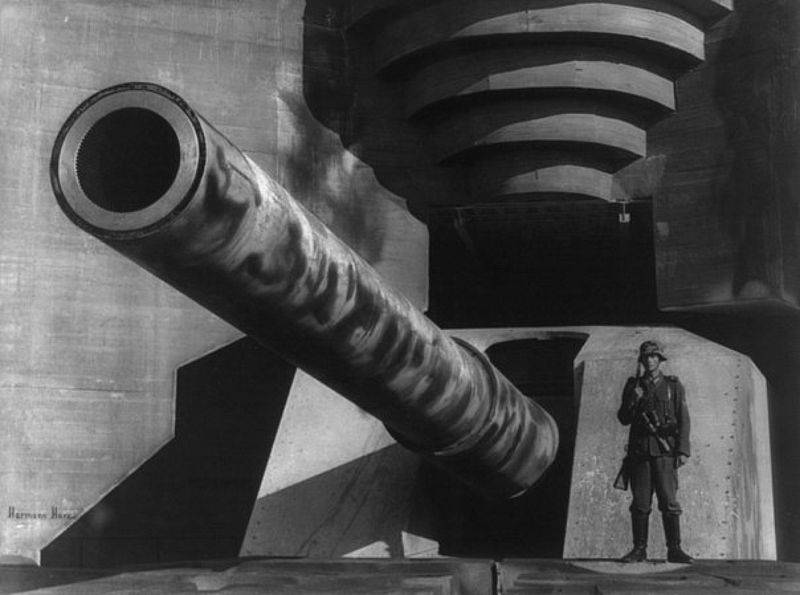
Lindemann battery. German sentry at the post near the 406-mm gun
Later, in 1942, lightweight high-explosive fragmentation shells were designed specifically for coastal defense guns. These 610-kg ammunition at the maximum elevation of the gun developed a flight speed of up to 1050 m / s, and the maximum firing range soared to 56 km.
406-mm coastal battery guns were placed in single installations Schiessgerät C / 39, providing elevation angles from -5 to +52 degrees. For additional protection, they were covered with concrete casemates. The armored towers were located in the circular courtyards of concrete casemates, deepened into the ground to a depth of more than 11 meters. The calculation of each gun consisted of 68 people, including 8 officers.
One of the batteries, consisting of three guns, was positioned by the Germans near the small French town of Sangatte to the west of Calais. The battery was named Lindemann. Since the fall of 1942, this battery has been firing at Dover in Great Britain and the Strait of Dover. In total, 1942 shells were fired across Dover from 1944 to 2226 (up to the capture of battery positions by Canadian troops).
The Germans placed two more batteries in Norway, in 1941 they sent 8 guns there, but one of them sank in transit. Coastal batteries armed with 406 mm 40 cm SKC / 34 guns were used by the Germans to protect Narvik and Tromsø. After the end of World War II, these guns went to the Norwegian army. The last time they fired was in 1957, and in 1964 the batteries were finally disbanded.
The main caliber of battleships of the "Soviet Union" type
In the Soviet Union, as in Germany, there were ambitious plans for the development of the fleet before World War II. In the late 1930s and early 1940s, four Project 23 battleships of the Soviet Union type were laid down within the framework of the approved program for the construction of the Big Sea and Ocean Fleet in the USSR. Soviet battleships were supposed to be the largest and most powerful in the world, but none of them was completed.
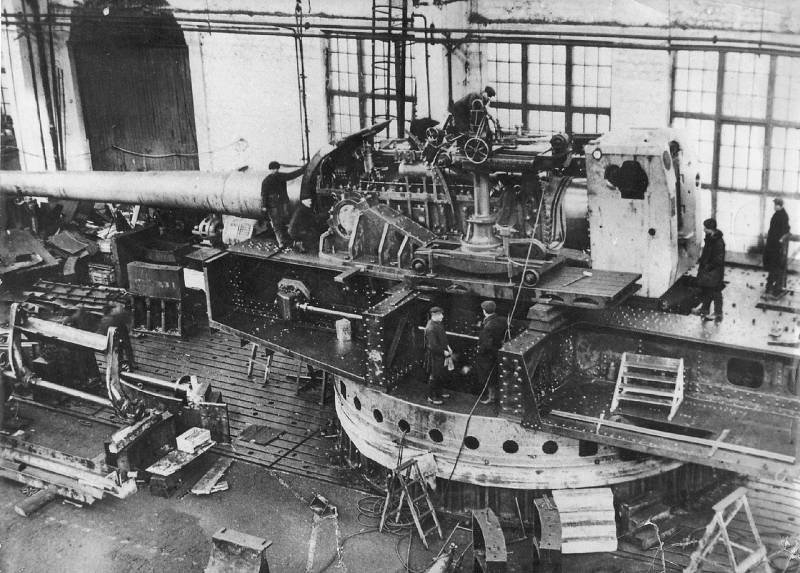
Gun B-37 in a single-barrel experimental installation MP-10 in the shop Novokramatorsky plant, 1939 year
The construction of battleships was stopped after the start of the Great Patriotic War, at that time the readiness of the head battleship Sovetsky Soyuz, laid down in 1938 in Leningrad, was 19,44 percent. And if battleships were never created, then the main caliber artillery was developed for them. The artillery armament of the Soviet super-battleships was based on the 406-mm B-37 naval cannon. It was planned to arm the battleships with 9 such main battery guns, arranged in three turrets.
In connection with the termination of the project of battleships of the "Soviet Union" type in July 1941, work on the further development of the B-37 naval gun and the MK-1 turret for it were curtailed. At the same time, a ready-made experimental single-barreled polygon MP-10 with a 406-mm B-37 gun took part in the defense of Leningrad. During the period of hostilities, the gun fired 81 shells at the German troops in the vicinity of the city.
The first B-37 gun was ready by December 1937, the guns were assembled at the Barricades plant. In total, 12 guns and five swinging parts for them, as well as a batch of shells, were fired. By the beginning of World War II, one of the guns in the MP-10 experimental installation was located at the Research Artillery Range near Leningrad (Rzhevka).
Due to its enormous weight, it was not possible to evacuate the installation, so the gun turned out to be a participant in the defense of the city on the Neva. The installations had time to prepare for all-round fire and additionally booked. The Soviet 406-mm cannon fired the first shots at the advancing German troops on August 29, 1941.
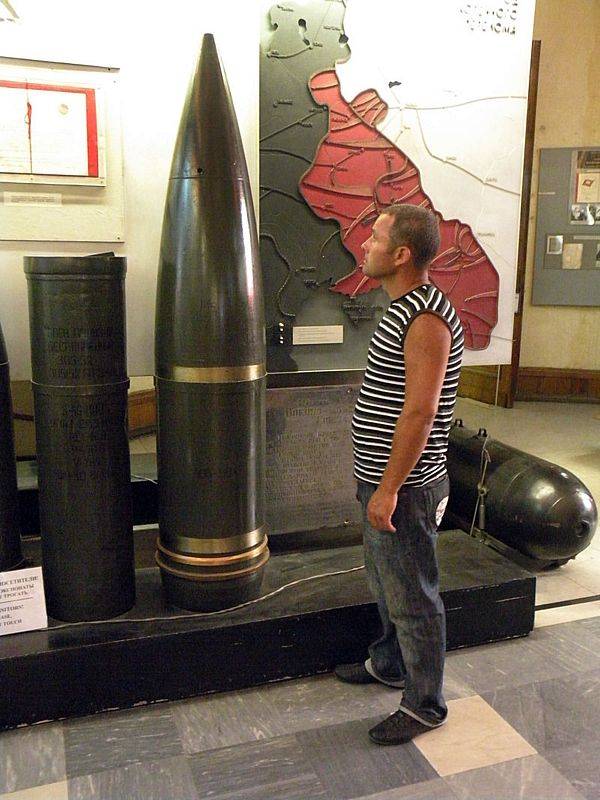
406-mm shell for the B-37 cannon. Exhibit of the Naval Museum, St. Petersburg
Being under the shells of this weapon was extremely unpleasant. 406-mm armor-piercing shells weighing 1108 kg left behind a funnel with a diameter of 12 meters and a depth of up to three meters. Depending on the elevation angle of the gun, the rate of fire should have been from 2 to 2,6 rounds per minute. The survivability of the fastened barrel was 173 shots, which was confirmed during the tests. The maximum firing range of the gun was approximately 45 km.
The weight of the B-37 gun barrel with the bolt was 136 690 kg, the barrel length was 50 calibers. The lifting angles of the gun ranged from -2 to +45 degrees. For firing a gun, it was planned to use armor-piercing, semi-armor-piercing and high-explosive shells. The latter did not have time to develop. At the same time, an armor-piercing 406-mm projectile weighing 1108 kg developed an initial velocity of 830 m / s when fired. At a distance of 5,5 kilometers, such a projectile is guaranteed to penetrate an armor plate 614 mm thick.
After the end of the war, the use of the MP-10 experimental installation for shooting new ammunition continued in the 1950s and 1960s. To this day, one installation with the B-37 gun has survived, which is still located at the Rzhev artillery range near St. Petersburg.
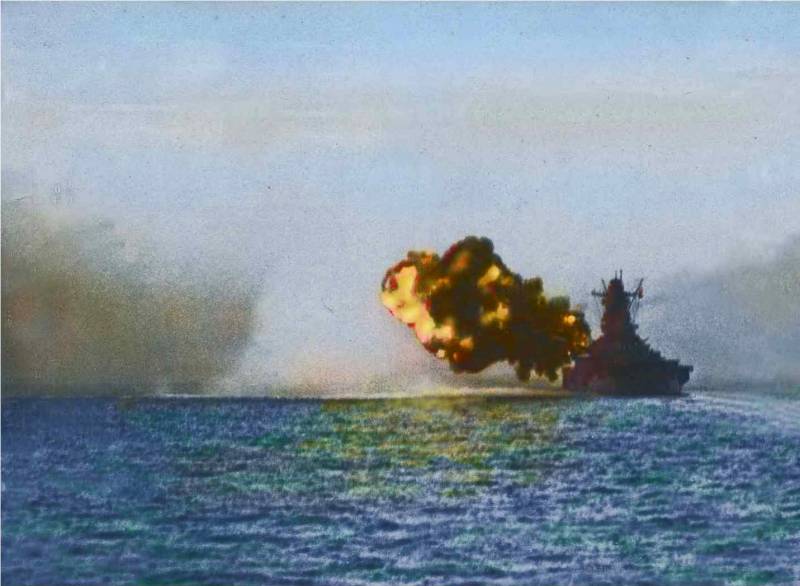
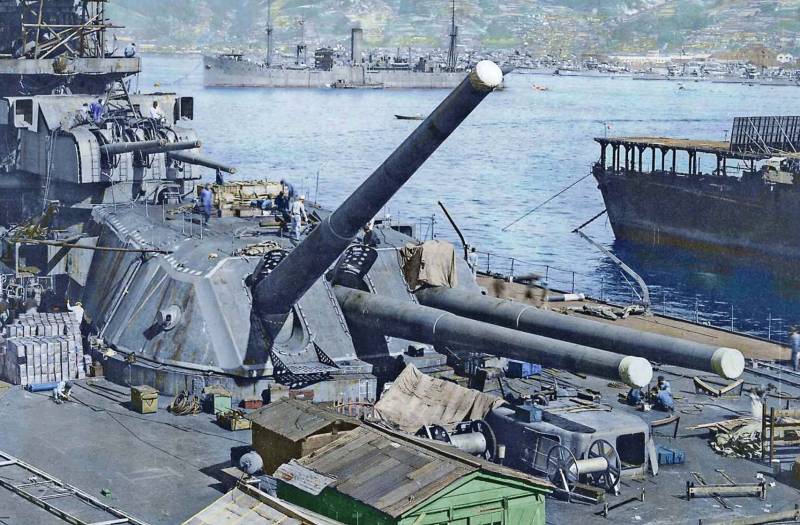
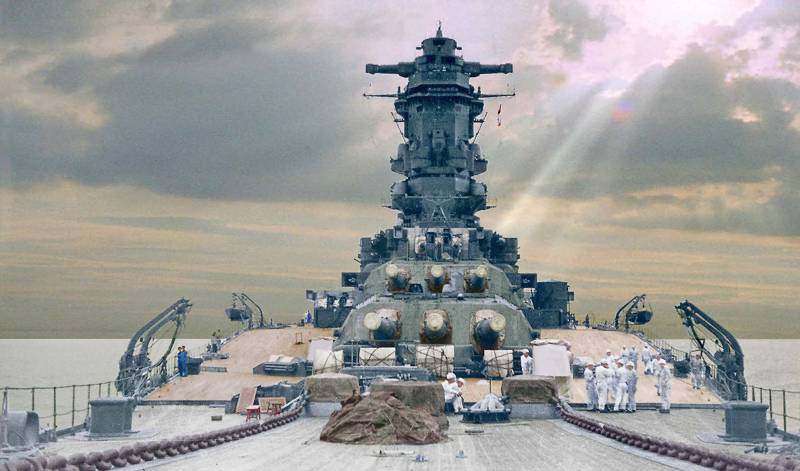
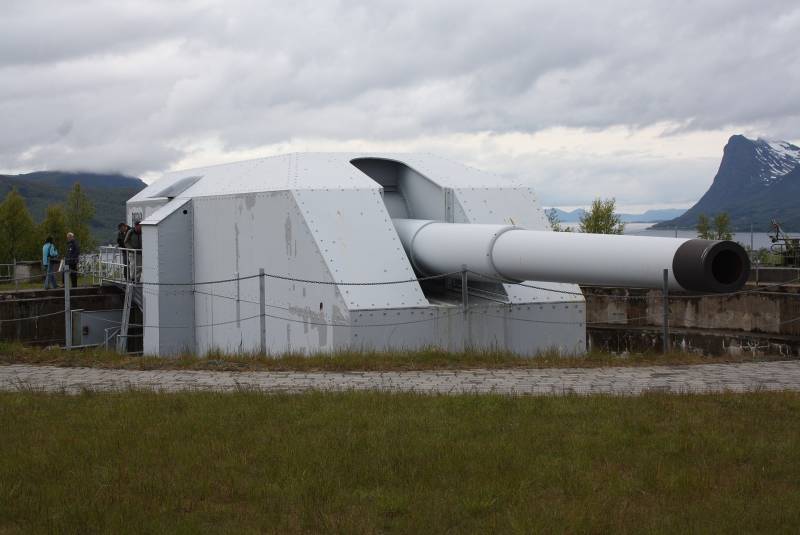
Information